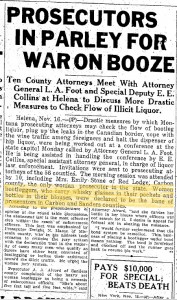
In November 1916, Montana voters approved a referendum for the statewide prohibition of alcohol. Montana’s influential and well-organized branch of the Women’s Christian Temperance Union had led the effort to ban the manufacture and sale of liquor. The passage of the new law, which went into effect at the end of 1918, reflected the growing influence of female reform in Montana. Not all Montana women supported temperance, however, and, ironically, for some women, the ban on liquor created new and lucrative—albeit illegal—economic opportunities.
Although Montanans were pioneers in the Prohibition movement, the law itself did little to curb drinking. Historian Michael Malone pointed out that the “enforcement of the law in wide open and fun-loving Montana proved nearly impossible.” Moreover, the state’s remoteness and abundant supply of wheat created ideal conditions for a thriving bootlegging economy. Although we now imagine bootlegging as a masculine activity dominated by gun-toting gangsters, in fact many women were quick to cash in on the illegal liquor trade. Women around the state manufactured moonshine and operated “home speaks” and roadhouses to supplement the family income. Because it could be done at home in the kitchen, making “hooch” was an especially attractive industry for working-class women hoping to supplement their family incomes and for widows who could not easily work outside the home.
Given the strength of drinking culture in Butte, it is perhaps unsurprising that female bootleggers thrived in that “wide open” mining town. When Butte voters opposed the Prohibition referendum in 1916, one dry advocate had explicitly criticized the city’s women who, she scolded, wouldn’t vote for prohibition “because you want to have beer on your own tables in your own homes.”

Butte’s female bootleggers included such diverse practitioners as Nora Gallagher, a widow who brewed in her kitchen so she could purchase Easter outfits for her five children, and eighty-year-old Lavinia Gilman, who was caught running a three-hundred-gallon still. Because many bootlegging operations were family affairs, children often participated as well. Helen McGonagle Moriarity recalled her role in her mother’s liquor trade, which was cleverly paired with her existing laundry business. Moriarity’s mother, Mary Ann, washed for miners living in a boardinghouse. As a teenager, Helen delivered booze hidden among the clean clothes for “fifty cents a pint and two dollars a gallon.”
A woman did not have to live in one of Montana’s urban areas to benefit from the underground liquor trade that Prohibition created. Female homesteaders, both married and single, supplemented their farm incomes with bootlegging. Bertie (Birdie) Brown, an African American woman from Missouri who homesteaded in eastern Fergus County, made home brew that locals described as the “best in the country.” Tragically, Brown died from burns she received when her still exploded in 1933.
Perhaps the most fantastic story of a homesteading bootlegger is that of Josephine Doody, a former dance-hall girl who brewed moonshine at her remote cabin on the southern edge of Glacier National Park. According to the legend, Doody’s future husband, Dan, a ranger at the park, had met and fallen in love with Josephine after seeing her at a dance hall in the railroad town of McCarthyville. Wishing to rid her of her opium habit, Dan tied Josephine to his mule, took her to his homestead, and locked her up to break her addiction. After Dan died in 1919, Doody remained at the homestead and became famous for her moonshine.
Researching Doody’s life, author John Fraley found that the men working on James Hill’s Great Northern Railway became her best patrons: “[T]he train would stop at Doody siding, and each toot of the whistle would mean one gallon of moonshine. Josephine delivered it across the Middle Fork of the Flathead River in a small boat.” Doody died of pneumonia in 1936, and since then her legend has only grown. In 2009, a group of history buffs erected a headstone for her unmarked grave in Conrad. It reads, “Josephine Doody, October 16, 1853, January 16, 1936. The Bootleg Lady of Glacier Park.”
The Twenty-first Amendment to the U.S. Constitution, ratified on December 5, 1933, repealed the Eighteenth Amendment and ended national Prohibition. Ironically, many of the same women who had first supported the “Great Experiment” now pushed for legalizing the sale of liquor because of the perceived increase in crime and public vice that accompanied Prohibition. For those women who had benefitted from bootlegging, the end of Prohibition spelled the end of a valuable economic opportunity. The resumption of legal channels for the manufacture and procurement of liquor meant less demand for their homemade hooch. AH
Not all women appreciated the art of bootlegging. In fact, women played an instrumental role in the passage of Prohibition at both the state and federal level. To learn more, read Cultivating Female Reform: The Montana Woman’s Christian Temperance Union.
Crime didn’t always pay. To read more about women who went to jail for their illicit activities, read Biased Justice: Women in Prison.
Sources
Baumler, Ellen. “Birdie Brown.” Montana Moments: A Blog of Funny, Bizarre, and Interesting Episodes from Montana History. Accessed 21 November 2013.
—. “Josephine Doody.” Montana Moments: A Blog of Funny, Bizarre, and Interesting Episodes from Montana History. Accessed 21 November 2013.
Carter, Sarah, ed. Montana Women Homesteaders: A Field of One’s Own. Helena, Montana: Farcountry Press, 2009.
Daily Inter Lake (Kalispell), April 24, 2009, in Doody, Josephine Vertical File, Montana Historical Society Research Center.
Malone, Michael P. “Montana Politics at the Crossroads, 1932-1933.” Pacific Northwest Quarterly 69, no. 1 (January 1978): 20-29.
Missoulian, July 22, 2012, in Doody, Josephine Vertical File, Montana Historical Society Research Center.
Moriarity, Bill. “’Gibraltar’ against Prohibition,” April 18, 2003, in Prohibition Vertical File, Montana Historical Society, Helena.
Murphy, Mary. “Bootlegging Mothers and Drinking Daughters: Gender and Prohibition in Butte, Montana.” American Quarterly 46, no. 2 (June 1994): 174-94.
—. Mining Cultures: Men, Women, and Leisure in Butte, 1914–41. Urbana: University of Illinois Press, 1997.